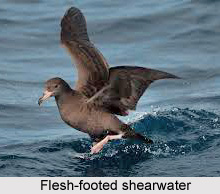 Flesh-footed Shearwater and Indian marine bird with a scientific name "Puffinus carneipes" is a medium-sized shearwater. This species has an extremely large range, and hence does not approach the thresholds for Vulnerable under the range size criterion. The population trend appears to be stable so the species does not approach the thresholds for Vulnerable under the population trend criterion. And now the population size is very large, and hence does not approach the thresholds for Vulnerable under the population size criterion.
Flesh-footed Shearwater and Indian marine bird with a scientific name "Puffinus carneipes" is a medium-sized shearwater. This species has an extremely large range, and hence does not approach the thresholds for Vulnerable under the range size criterion. The population trend appears to be stable so the species does not approach the thresholds for Vulnerable under the population trend criterion. And now the population size is very large, and hence does not approach the thresholds for Vulnerable under the population size criterion.
Structure of Flesh-Footed Shearwater
The plumage of Flesh-footed shearwater is black. Flesh-footed shearwater has pale pinkish feet, and a pale bill with a distinct black tip. Together with the equally light-billed pink-footed shearwater, it forms the Hemipuffinus group, a super species which may or may not have an Atlantic relative in the great shearwater. These are large shearwaters which are among those that could be separated in the genus Ardenna.
Breedings and Concentration of Flesh-Footed Shearwater
Flesh-Footed Shearwater breeds in colonies, and has two main breeding areas: one in the southwest Pacific Ocean that includes Lord Howe Island South Australia, and northern New Zealand the other population comprises no more than 36,000 pairs breeding on 42 islands along the coast of Western Australia from Cape Leeuwin to the Recherche Archipelago. Another 500 pairs breed on St Paul Island in Indian Ocean. There is an unconfirmed record of birds on Astola Island of Pakistan in the Arabian Sea. There is recent evidence to suggest populations are declining across much of the species range. The species was recently listed as `Near Threatened` in Australia and "Nationally Vulnerable" in New Zealand and has been recommended for listing under the Agreement on the Conservation of Albatrosses and Petrels.
Migration of Flesh-Footed Shearwater
Flesh-footed shearwater occurs as a Boreal summer visitor in the North Pacific Ocean where potentially large numbers are taken as by-catch in fisheries. The species also suffers from climate related impacts and significant heavy metal contamination, the cause of which is not fully understood but is likely due to the ingestion of significant quantities of plastic which the birds mistake for food floating on the ocean surface.



















